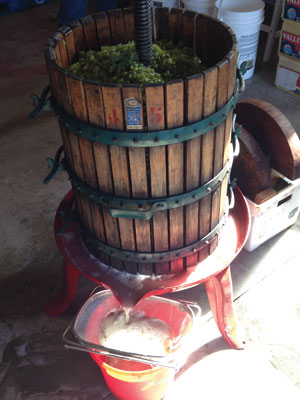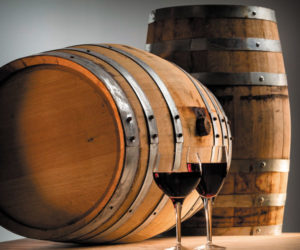Q
Last year I brought out our press and found the slats covered in a white mold, so we took it upon ourselves to use 180 °F (82 °C) water to clean the press slats, and figured that would do it. After the 2016 harvest, and press, we sanitized it with SO2 sanitizer solution. The press again has mold on it. Help!
Philip Feiner
San Carlos, California
A
Ah, yes, the joys of wood. We use wood in the winery for barrels and barrel-alternatives of course but, especially for the small-scale winemaker, wooden presses are still often part of our crush equipment.
It’s interesting, but not strange, that this mold pops up periodically. I would scrutinize your ambient humidity and temperature; it’s very possible this mold bloom was caused by a change in the weather or a change in your cellar environment. Once, while working out of a winery in Santa Cruz, California, we noticed that we tended to grow mold on the outside of our wooden upright tanks when we experienced a period of particularly wet, damp, and muggy weather. When the sun came out and it warmed up for good, we cleaned and dried the tanks well (installing a couple of big fans blowing outside air into the tank room) and the white mold didn’t come back until the following fall. At another winery on California’s Central Coast, I used to have a small wooden press and we occasionally experienced the same problem you describe above: White mold growth on the press during storage. If cleaned off periodically I always felt its danger to my wines was limited, but it certainly was unsightly. The key to mold prevention is to maintain cleanliness in a moisture-balanced environment. To follow is some of my best advice to help manage your mold:
• Clean, sanitize and dry well.
When I saw my mold develop, I would drag the press out onto the crush pad (a shaded, well-ventilated area is ideal), take it apart and attack it with a pressure washer. A steam cleaner can work great too, and really opens up the pores of the wood. Then I would give it a thorough going-over with a scrub brush or plastic scrubby pad using a solution of sodium percarbonate, known commercially as “Peroxycarb.” It’s good to really get in the nooks and crannies with an old toothbrush to make sure you’re lifting out all of the mold that you possibly can.
Give a good clean water rinse, followed by a rinse-off with a citric acid/sulfur dioxide solution. Dissolve 3 grams potassium metabisulfite and 12 grams of citric acid in 1 gallon (3.8 L) of water. This will produce a strong sulfur-dioxide solution that is very anti-microbial. Be sure to wear a respirator mask when working with sulfur dioxide solutions or gas as it’s not friendly to the lungs. Let the sulfur dioxide stand on the wood for about 15 minutes and then rinse off with water.
Allow the parts of the press to dry. It’s ideal to do this operation early on in a warm day so the wood will have time to dry completely before night falls and dew forms on the wood. Use a fan if necessary to dry the press completely. Store the press assembled or un-assembled, as you choose. If you put it back together again, you’re just going to have to unpack it and re-sanitize before harvest anyway. Depending on how big and awkward it is for your storage space, it seems easier to me to store it unassembled.
• Store away from UV light
Over time, UV light can degrade wood so it’s a good idea to store your press (and especially barrels) inside. If you don’t have a good place indoors, a last resort is a well-shaded spot. When I’ve been forced to store a wooden press outside, I’ve covered it up with a loosely wrapped tarp to further protect it from the elements. If you have to store a tarp outside, just make sure it’s somewhere that rainwater won’t fall on or blow into it. Nothing like a plastic tarp “mummy” to trap water and encourage even more mold growth!
• Store in a cool place with some (but not too much) humidity
I reached out to a few of my barrel suppliers while answering this question because, after all, they are the wood care experts. With a good French oak barrel averaging around $1,000, they’d better know how to protect their stock. Mario Carofanello, of Radoux Cooperage, says, “We store the barrels between 47-53% humidity at 67–72 °F (19–22 °C) at the cooperage.” Too dry and over time the wooden press slats can dry out and crack. Too wet and you’ll just encourage more mold growth.
• Use mildewcides advisedly
Of all the of wineries I’ve worked out of in the last 15 years, only two ever used mildewcide (often sold under the brand name O’Sullivan X650) on the outside of their barrels to help repel mold growth and wood borers. “Mildewcide” as it’s sometimes called, is an acrylic paint impregnated with USDA approved fungicides. It comes in a paint can and is painted on with a brush, roller or sprayer. When I’ve used it in the past it’s sort of waxy, sort of like a clear-ish paint and dries to a varnish-like finish. It does help to repel wine stains and will help keep your barrels looking nicer over the years, but I’ve always wondered if it inhibits barrel breathability. For barrels, it’s meant to be used on the outside only and never contact the wine. It should not be used on a wine press because pretty much every surface on a press will contact the wine at some point, especially on a messy day.
Q
Is it okay to use a magnesium sulfate spray on Marechal Foch? Do the sulfate ions in solution have any damaging effects similar to using a pure sulfur spray?
William Foster
via e-mail
A
Magnesium Sulfate (MgSO4), AKA Epsom salts, is a very common vineyard amendment. It can be applied as a foliar spray during the growing season to provide vines with magnesium and sulfur. Magnesium, especially, is critical for photosynthesis. I talked to Hans Walter-Peterson, Viticultural Extension Specialist with Cornell University about the use of magnesium sulfate sprays in the vineyard and if we should be concerned about using them during the grape-growing year.
Basically, it’s fine to use during the growing year but you need to watch out as you approach harvest. As you allude to above, elemental sulfur is sometimes sprayed on vines to control powdery mildew and growers should be careful not to apply it too close to picking. Mr. Walter-Peterson tells me that MgSO4 will not break down into elemental sulfur, per se, but will break down into magnesium and sulfate ions. During fermentation, Saccharomyces cerevisiae can reduce environmental sulfate into sulfide. The yeast then incorporates some of the sulfide into amino acids, which can lead to the production of stinky volatile sulfur compounds (VSCs), with any excess converted to hydrogen sulfide (H2S). H2S can be a major sensory defect, stinking like rotten eggs. Therefore, the correct timing of MgSO4 sprays is just as important as elemental sulfur sprays.
Mr. Walter-Peterson shared some data from Cornell University that looked at the timing of sulfur sprays and its effects on hydrogen sulfide production in red and white wines. He summarized, “In a nutshell, for white winemaking, almost all sulfur residues settle out before fermentation, so there’s greater leeway there. For reds, if sulfur sprays stopped 6–8 weeks before harvest, very little elemental sulfur was found in must and thus little contribution to H2S formation.”
Since MgSO4 can release a sulfate ion, which just like elemental sulfur can continue down the sulfide reduction pathway to become H2S during fermentation, growers and winemakers need to be cognizant of when MgSO4 is applied. Mr. Walter-Peterson concluded, “So at a minimum and being super conservative, applying MgSO4 up to 5–6 weeks or so before harvest shouldn’t be a problem in reds. Applying on whites shouldn’t be a problem even closer to harvest.” I will leave it up to you to find your own comfort zone. Realistically, however, since MgSO4 is a foliar nutrient spray it is most often applied well before harvest, typically a few times around berry set. Mr. Walter-Peterson recommends a rate of 5–10 lbs. (2.3–4.5 kg) of MgSO4 to 100 gallons (380 L) of water per acre. Too close to harvest is too late to do your vines any good from a nutrient point of view so if you spray early, you don’t have to worry about MgSO4 contributing to sulfide and VSC defects in your wine.
Amendment From June-July 2017 Wine Wizard
Dear Wine Wiz Readers,
Last issue, as part of a larger question from a reader about TCA (trichloroanisole, the “corked” aroma defect) prevention and management, I told readers about a “hack” I’ve heard about over the years. One soaks the wine in question with a fist-sized ball of plastic wrap, which will bind to the TCA to lessen its impact in the wine. Critically missing, however, was the important detail that the plastic wrap in question needs to contain PVDC (polyvinylidene chloride). A helpful and very knowledgeable reader, Rex Johnston, emailed WineMaker to help us clarify and update this response.0
Here’s an excerpt from my answer:
“What to do with your TCA-smelling wine? You could try a little “wino-hack” trick that seems a little weird but, if the chemistry is right, sometimes works. Try balling up a few fistfuls of plastic wrap like Saran Wrap, putting it into a pitcher (about a gallon or half-gallon size would work) and then pouring the offending wine over it. Let the wine and plastic wrap soak for a few minutes, give a stir, then pour off a sample of the wine into a glass. If it smells better, it means that some (or hopefully most!) of the TCA has absorbed onto the polyethylene plastic. Treat the rest of your wine this way and hopefully the level of TCA in your wine will reduce to such an extent that it can be consumed.
A TCA aroma defect is best prevented rather than treated. Never let any chlorine cleaning agents come into contact with anything in your winery, buy a charcoal filter from a hardware store to run in-line or at the end of any of your water hoses and make sure your corks are fresh and coming from a reputable supplier with high turnover. It takes a little vigilance to reduce the incidence of TCA contamination in your winery but in this case an ounce of prevention is worth a few parts per trillion of stinky TCA taint. “
Mr. Johnston wrote to say the following:
“Saran Wrap was invented by Dow Chemical where I once worked. The original Saran Wrap was polyvinylidene chloride (PVDC), which has since been sold to S. C. Johnson, who changed the formulation to a polyethylene product that is not polar. The original PVDC is very polar and acts like a magnet to TCA which is also polar thus binding it up. Handi-Wrap, the new formulation of Saran Wrap, and other polyethylene products are not polar and will not bind up the TCA. Strech-tite sold by Costco is PVDC and will remove the TCA.”
Bottom line? If you do want to try to treat your wine at home with this hack, which does seem to work, you need to make sure that the plastic wrap you are using contains PVDC. Costco, here we come!
Thanks for sharing your experience with us, Rex!






